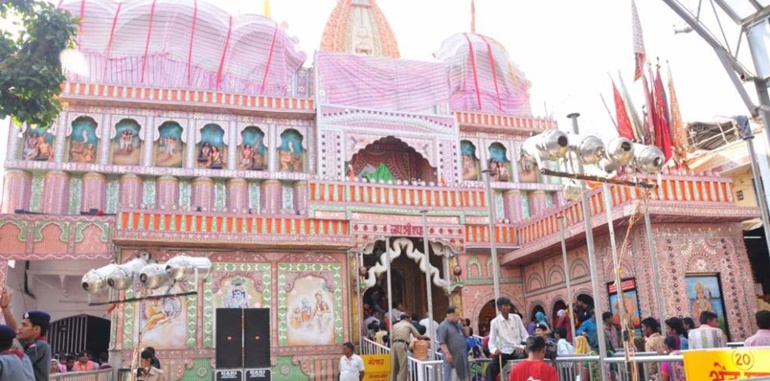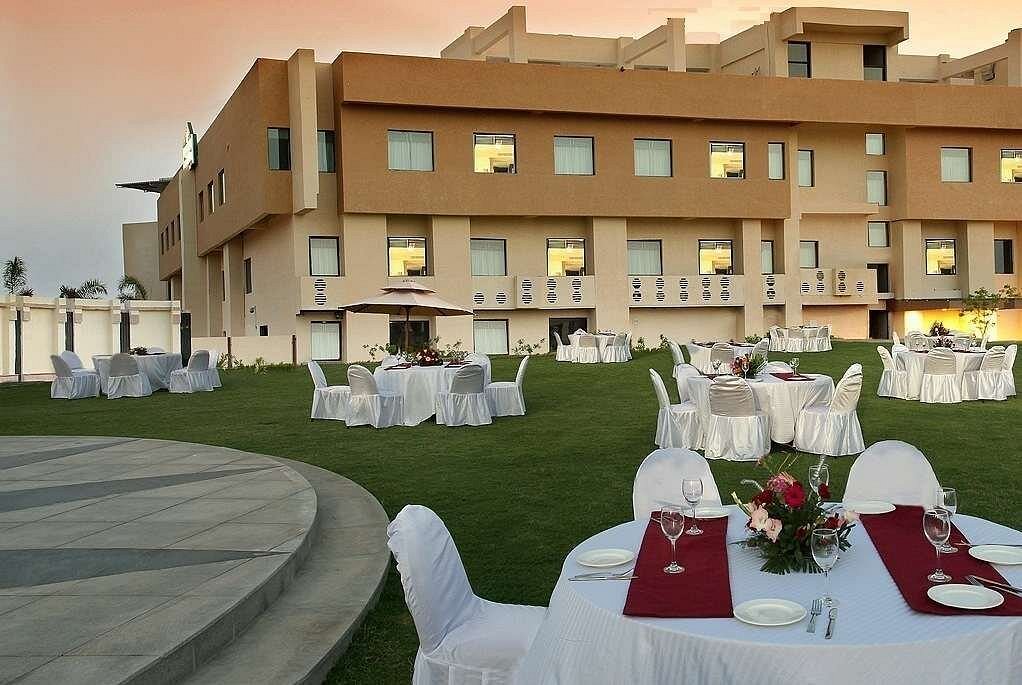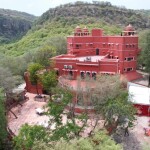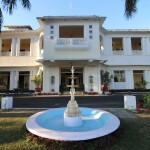A Review of Khatu Shyam Ji Temple, Rajasthan
Khatu Shyam Ji Temple is a Hindu temple located in the village of Khatoo, near Sikar city in Rajasthan. It is dedicated to the worship of Khatu Shyam Ji, who is believed to be the manifestation of Barbarika, the son of Ghatotkacha and grandson of Bhima. Barbarika was a brave warrior who sacrificed his head to Lord Krishna before the Mahabharata war and was granted a boon to be worshipped in the Kali Yuga as Shyam Ji. The temple is a popular pilgrimage site for devotees who seek the blessings of Khatu Shyam Ji and admire the architectural beauty of the temple.
Table of contents [Show]
Location
The temple is situated in the Khatoo village, which is about 43 km from Sikar city and 80 km from Jaipur, the capital of Rajasthan. The nearest railway station is Reengus, which is 18 km away. The nearest airport is Jaipur International Airport, which is 95 km away. The temple can be reached by road from various cities of Rajasthan and neighboring states.
Accessibility
The temple is easily accessible by road from various parts of Rajasthan and neighboring states. There are regular buses and taxis available from Sikar, Jaipur, Delhi and other cities. The temple also provides free bus service from Reengus railway station for the convenience of pilgrims. The temple complex has ramps and wheelchairs for the physically challenged visitors.
Accommodation
There are many options for accommodation near the temple, ranging from budget hotels to luxury resorts. The temple also has its own guest houses and dharamshalas that provide comfortable stay at nominal charges. Some of the popular hotels near the temple are:
- Hotel Shyam Palace
- Hotel Shyam Resort
- Hotel Shyam Paradise
- Hotel Shyam Heritage
- Hotel Shyam Villa
Attractions
The main attraction of the temple is the idol of Khatu Shyam Ji, which is made of rare stone and is enshrined in the sanctum sanctorum. The idol has a mesmerizing aura and attracts devotees from far and wide. The temple also has a large prayer hall called Jagmohan, which is adorned with beautiful paintings depicting mythological scenes. The entrance and exit gates of the temple are made of marble and have ornamental floral designs. The shutters of the sanctum sanctorum are covered with a silver sheet that adds to the grandeur of the temple.
Another attraction near the temple is the Shyam Kund, which is a holy pond where the head of Barbarika was found buried. It is believed that taking a dip in this pond can cure diseases and bring good health. Many pilgrims take a bath in this pond during the Phalguna Mela Festival, which is held every year in February-March.
Activities
The temple offers various activities for the visitors, such as:
- Participating in the daily rituals and ceremonies of the temple, such as aarti, bhajan, kirtan and prasad distribution.
- Attending the special festivals and events celebrated at the temple, such as Janmashtami, Holi, Diwali, Basant Panchami and Phalguna Mela.
- Shopping for souvenirs and religious items at the shops near the temple.
- Exploring the nearby attractions such as Harshnath Temple, Jeen Mata Temple, Salasar Balaji Temple and Rani Sati Temple.
Safety
The temple is generally safe for visitors, as there are security guards and CCTV cameras installed at various points. However, some precautions should be taken, such as:
- Avoiding crowded areas and keeping an eye on your belongings.
- Following the rules and regulations of the temple authorities.
- Respecting the sentiments and customs of the local people.
- Avoiding any kind of argument or dispute with anyone.
Cost of Living
The cost of living near the temple is affordable, as there are many options for food, accommodation and transportation that suit different budgets. The average cost per day for a person can be estimated as follows:
| Item | Cost |
|---|---|
| Food | Rs. 200 |
| Accommodation | Rs. 500 |
| Transportation | Rs. 100 |
| Miscellaneous | Rs. 100 |
| Total | Rs. 900 |
Local Hospitality
The local people near the temple are hospitable and helpful towards the visitors. They are proud of their culture and heritage and share their stories and experiences with enthusiasm. They also offer guidance and assistance to the pilgrims and tourists. They are friendly and courteous and expect the same from the visitors.
Sustainability and Responsible Tourism
The temple is committed to the sustainability and responsible tourism of the region. It has taken various measures to preserve the environment and promote the social and economic development of the local community. Some of the measures are:
- Using solar panels and LED lights to save energy and reduce carbon footprint.
- Installing rainwater harvesting systems and water recycling plants to conserve water and prevent wastage.
- Providing free medical camps and education programs for the poor and needy people of the village.
- Supporting the local artisans and craftsmen by promoting their products and skills.
- Encouraging the visitors to follow the eco-friendly practices such as avoiding plastic bags, littering, noise pollution and animal abuse.
Personal Experience
I visited the Khatu Shyam Ji Temple in March 2023, during the Phalguna Mela Festival. It was a memorable experience for me, as I witnessed the devotion and enthusiasm of thousands of pilgrims who thronged the temple to seek the blessings of Khatu Shyam Ji. The temple was beautifully decorated with lights and flowers, and the atmosphere was filled with joy and festivity. I participated in the rituals and ceremonies of the temple, such as aarti, bhajan, kirtan and prasad distribution. I also took a bath in the Shyam Kund, which was refreshing and rejuvenating. I felt a sense of peace and happiness in my heart, as I gazed at the idol of Khatu Shyam Ji, which had a captivating aura. I also explored the nearby attractions such as Harshnath Temple, Jeen Mata Temple, Salasar Balaji Temple and Rani Sati Temple, which were equally impressive and fascinating. I enjoyed the local cuisine, which was delicious and spicy. I also shopped for some souvenirs and religious items at the shops near the temple. I met some friendly and helpful local people, who shared their stories and experiences with me. They also offered me guidance and assistance whenever I needed. I was impressed by their hospitality and culture. I also appreciated the efforts of the temple authorities to maintain the cleanliness and security of the temple complex. They also ensured that the visitors followed the rules and regulations of the temple. They also promoted the sustainability and responsible tourism of the region by implementing various eco-friendly measures.
Best Timings
The best time to visit the Khatu Shyam Ji Temple is during the Phalguna Mela Festival, which is held every year in February-March. This is when the temple is at its peak of glory and splendor, as thousands of devotees flock to the temple to celebrate the festival. The festival is marked by various cultural and religious events, such as musical concerts, dance performances, processions, fairs, fireworks and more. The festival is a spectacle of colors, sounds and emotions that one should not miss.
However, one can also visit the temple at any time of the year, as it is open throughout the year. The temple has a pleasant climate all year round, except for some extreme weather conditions in summer and winter. The temple is open from 4:30 am to 9:00 pm on weekdays, and from 4:30 am to 10:00 pm on weekends.
Conclusion
Khatu Shyam Ji Temple is a must-visit destination for anyone looking for a spiritual experience in Rajasthan. The temple has a rich history and mythology that attracts devotees from all over India. The temple also has a stunning architecture that showcases the artistic skills of Rajasthan. The temple also offers various activities for visitors such as participating in rituals, attending festivals, shopping, exploring nearby attractions etc. The temple also provides comfortable accommodation options for visitors at reasonable prices. The temple also ensures safety and security of visitors by having security guards and CCTV cameras. The temple also promotes sustainability and responsible tourism by implementing eco-friendly measures such as using solar panels, rainwater harvesting etc. The temple also supports social and economic development of local community by providing free medical camps, education programs etc.
I hope this review article helps you to plan your trip to Khatu Shyam Ji Temple in Rajasthan. If you have any questions or feedbacks, please feel free to comment below.















